SWELL – Donemana WwTW (2021)
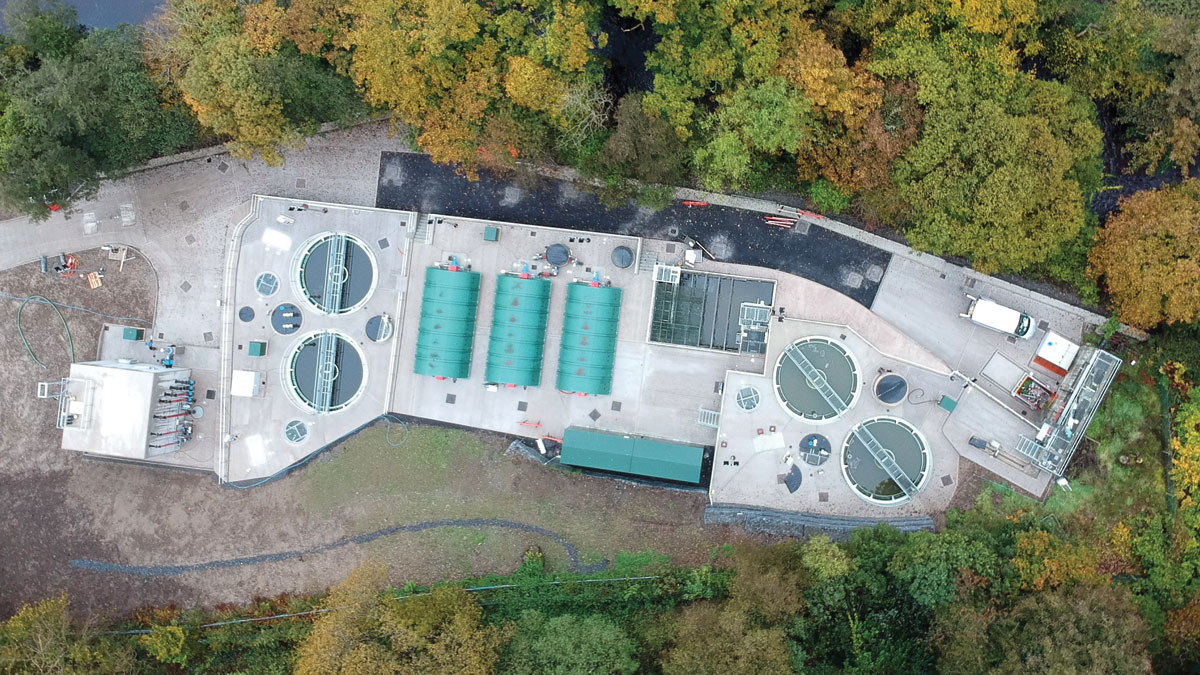
Aerial of SWELL upgraded Donemana WwTW - Courtesy of NI Water/SWELL
Donemana Wastewater Treatment Works (WwTW), located on the banks of the Burn Dennet River and at the foothills of the Sperrins in Co. Tyrone, serves the Donemana area – the largest of the thirteen villages in the Derry City and Strabane Council area. The existing works had been in service for almost 50 years with NI Water having to undertake continued investment in maintenance to achieve discharge compliance levels. Increasing population demands, resulting in greater pressure being exerted on the wastewater treatment works, meant that the existing assets were approaching the end of their design lives. A replacement wastewater treatment works, to be constructed as part of the EU-funded SWELL project, would see the installation of modern technology, incorporating two new primary settlement tanks, three new rotating biological contactors (fully enclosed tanks with built-in treatment capability), two new final settlement tanks, a new sludge holding tank and refurbished inlet works and storm tank.
The existing works
The existing treatment process at Donemana WwTW comprised of an inlet works including 6mm fine screening, a flat-bottomed primary settlement tank, a circular biological trickling filter bed and a flat-bottomed final settlement tank. Storm storage tanks and a sludge holding tank also existed at the site, as did a return liquor pumping station and sludge pumping station.
The replacement WwTW was designed to serve a projected population of 1,217 and constructed within the confines of the existing NI Water-owned land.
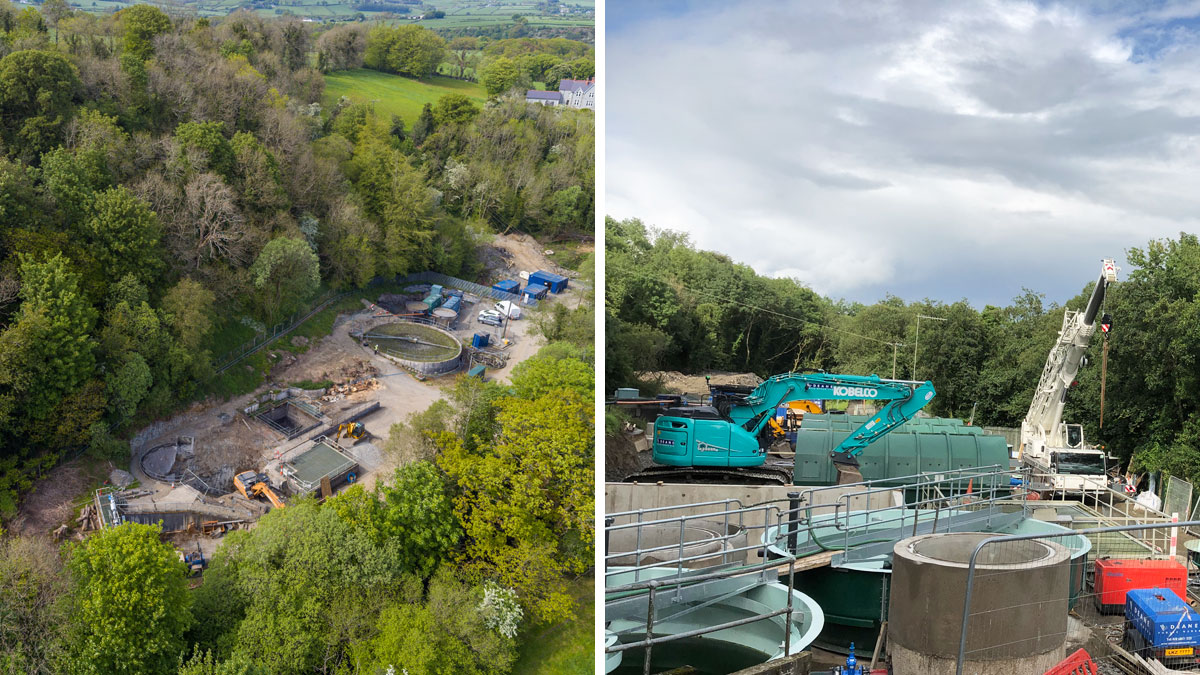
Work started at Donemana WwTW, a confined site, in June 2019 – Courtesy of Deane Public Works
Project drivers/need for improvements
During the planning stage of the SWELL project, Donemana was identified as having great potential to improve water quality within the Lough Foyle catchment.
The existing works, which was designed for a population equivalent of 634, was estimated to be receiving load from a population equivalent of 1,031 with a maximum FFT of 500 m3/day (5.8 l/s). The works was therefore biologically overloaded and operating beyond its full design hydraulic capacity.
Age, condition of the site, increased PE and regulatory requirements were all significant drivers for the project as follows:
- Future growth: To meet the future growth of the local population in the Donemana area to 2042 (25-year population growth projection – 1217 PE).
- Water quality discharge: To deliver environmental improvements through enhanced water quality discharge to the Burn Dennett River and improved water quality in Lough Foyle in accordance with European Directives.
- Design flexibility: To provide flexibility in the new design to permit future extensions and modifications in design flows, loads or consents with ease, economics and minimum disruption.
- Construction phase discharge consent standard: To phase construction of the new treatment works on a very restricted site whilst keeping the existing process operational to meet/achieve all construction phase discharge consent standards for the duration of the works.
- Environmental Impact: To promote sustainability and minimise visual impact, waste, disruption, noise, air quality (odour) effects.
Early contractor involvement/design and build contract
Deane Public Works (DPW) were appointed by NI Water as the main contractor in March 2018 under an NEC 3 Early Contractor Involvement (ECI) contract. DPW provided multi-disciplinary design, project and supply chain management and all civil engineering works for the contract from start to completion.
Process and MEICA designs were provided by our experienced key supply chain partners Water Solutions Ireland (WSI), who developed and delivered a full turnkey design and build solution for replacement of Donemana WwTW. Jacopa supplied the RBC units and WPL Ltd, the conical settlement tanks.
The ECI phase allowed DPW to align resources and integrate objectives with NI Water and their project management team from McAdam at an early stage to benefit delivery. This proactive approach led to enhanced collaboration, innovation, value, efficiency and reduced whole life costs for the project.
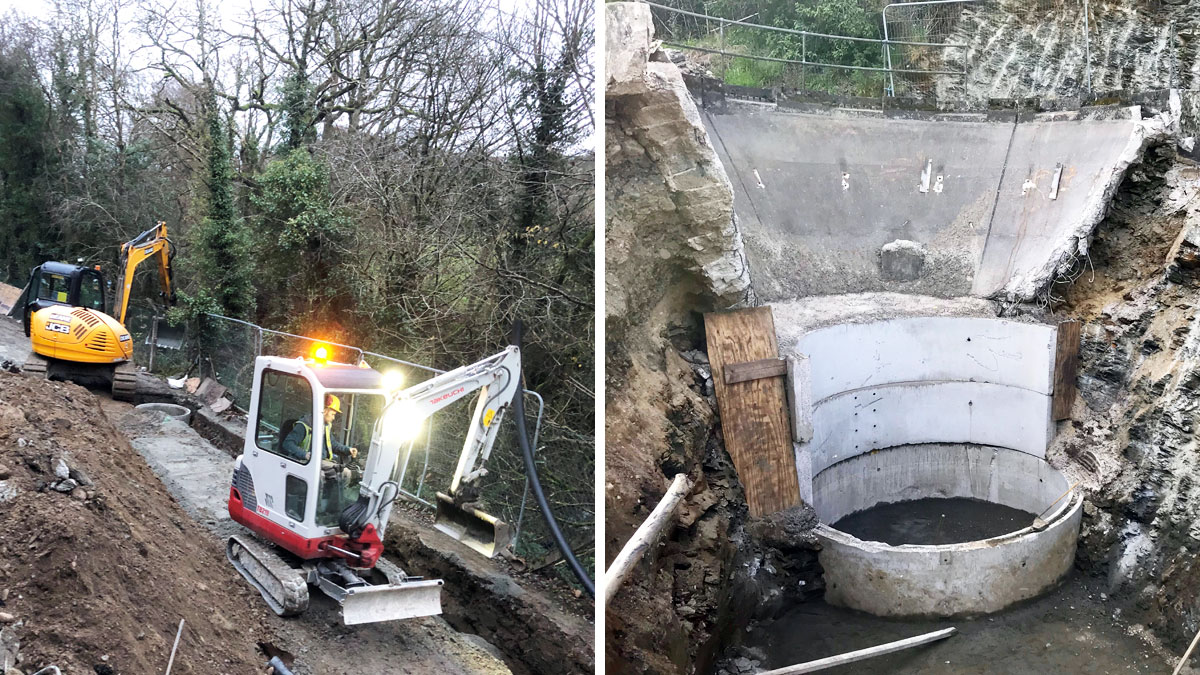
(left) Narrow working on site and (right) PST on the footprint of the original – Courtesy of Deane Public Works
Civil design
AECOM were appointed under a Professional Services Contract to DPW for all civil engineering design requirements, including the development of a high-resolution animation video to bring the 3D geometry of the final design to life at key project stages. The model assisted the DPW Integrated Project Team in developing construction sequencing for the major structures and coordinating the positioning of new pipework whilst existing pipework and services were kept operational.
The 3D model was an important tool for all design and HAZOP meetings and it also gave operations staff the opportunity to view the proposed completed works to aid clash detection and advise on design changes or pinch points.
Civil design included for the replacement of the existing retaining wall along the north west site boundary to help protect NI Water assets and operational personnel from potential landslides. A drainage system was developed as part of the design to transfer the flow from the berm across the site to the adjacent Burn Dennet River. The retaining wall surrounds and supports the primary sedimentation tanks, and a key design consideration was ensuring the formation levels maintained the correct hydraulic profile throughout the site. Other civil design requirements included temporary works, storm, primary and sludge holding tanks, pumping stations, roads and hardstanding areas, drainage, pipework and ductwork.
The replacement WwTW was designed on the existing confined site footprint in a phased manner whilst the existing works remained operational. This meant that NI Water didn’t need to make any land purchase to facilitate the plant upgrade.
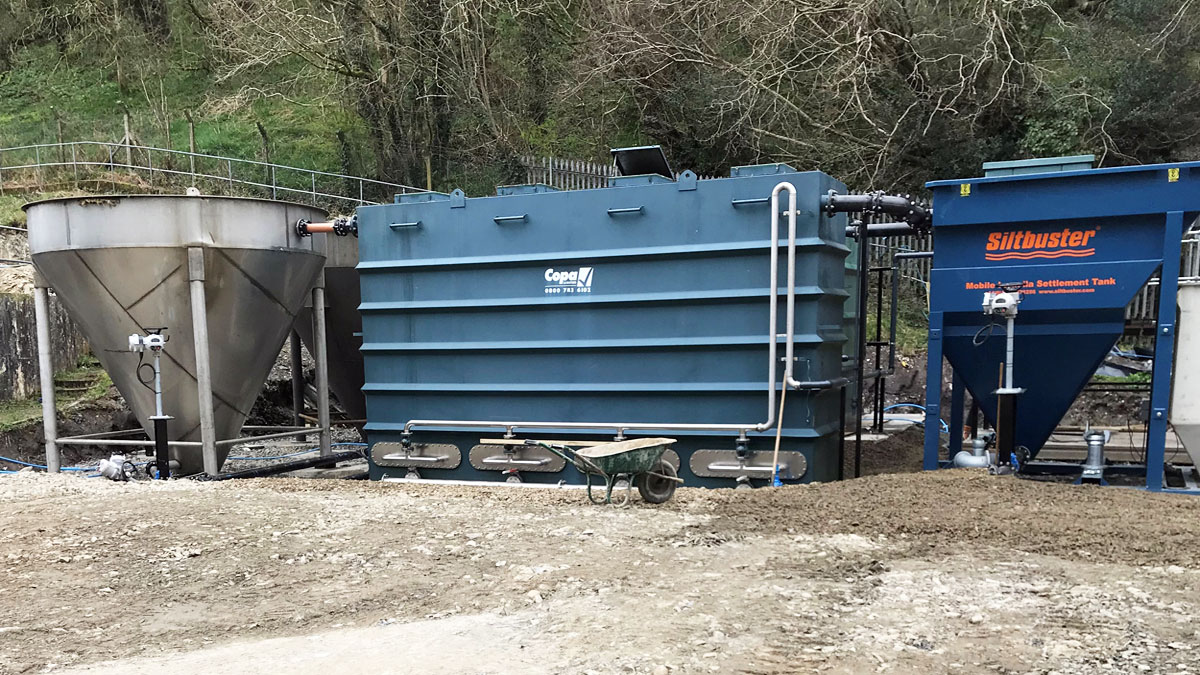
Temporary treatment plant – Courtesy of Deane Public Works
Process design
WSI designed a replacement process/MEICA plant for Donemana considering the best available technology/technique to provide low OPEX costs to serve a projected population of 1,217 within the confines of the existing site boundary.
Following design review of the existing Donemana WwTW, it was apparent that the available site footprint for a replacement works was limited and maintaining treatment capabilities (in line with current discharge consent standards), while constructing the new works, would prove difficult.
To overcome the challenge of the restrictive site, WSI identified redundant assets under the client’s portfolio that could be refurbished to form part of a final temporary treatment solution. WSI engaged their supply chain to fully develop a compact, low maintenance temporary treatment solution that would provide effective treatment during the construction phase.
The incoming flows at the existing inlet works and FFT flume were temporarily diverted to the temporary treatment plant. The incoming flows gravitated to a temporary lift pumping station which then passed forward flows to the treatment plant, comprising a flow split chamber, two settlement tanks, two SAF units – complete with an aeration blower kiosk for biological treatment – and a lamella tank downstream for final solids removal.
Construction phasing was kept to a minimum with a small number of assets from the existing site kept online, specifically the existing final settlement pumping station to lift the sludge flows from the temporary plant to a modified final settlement tank acting as a temporary sludge storage tank.
The temporary plant was operated and maintained throughout the construction phase by WSI and compliance with the 40:60 mg/l (BOD/suspended solids) discharge consent standard was maintained at all times.
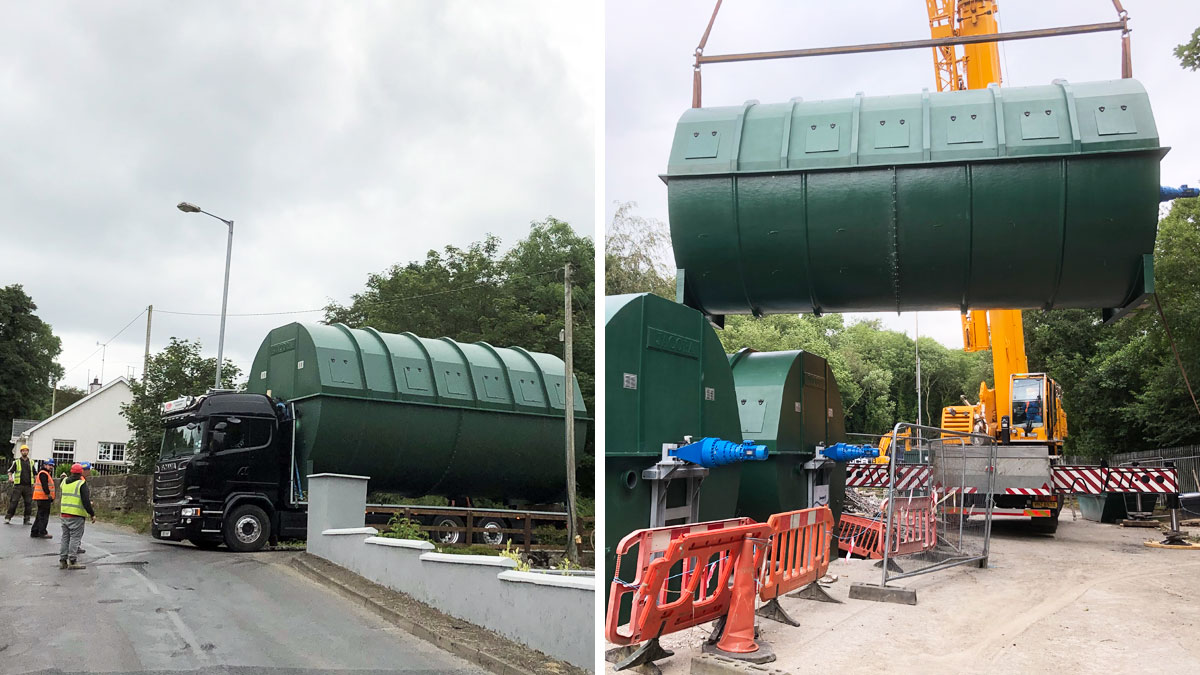
Delivery and installation of RBCs – Courtesy of Deane Public Works
The new replacement Donemana WwTW comprised of a refurbished inlet works (6mm screening) with improved flow control consisting of a greater than Formula A overflow discharging to the existing storm tank overflow pipework location, a greater than FFT overflow to the storm tank and pass forward flow control via a modulating penstock and FFT flume. All overflows are measured and recorded via provision of stainless steel weirs and new ultrasonic level transmitters. The existing storm storage tank was also refurbished to receive greater than FFT flows, storm tank Venturi mixer pump was installed, and the existing storm return pumps were replaced with variable speed storm return pumps for improved return flow control to the head of the works.
Downstream of the inlet works, an entirely new primary settlement stage was constructed. This stage comprises a primary settlement flow split chamber and two new 6.0m diameter 60° conical GRP primary settlement tanks for removal of solids. The two PSTs are fitted with an inlet diffusion drum, peripheral launders, GMS walkways and handrails, and automatic de-sludging using hydrostatic actuated valves with manual scum removal facilities.
A primary sludge pumping station was also provided for the co-settled sludge (primary and humus) and scum from the PSTs. The pumps provided are ATEX rated and capable of pumping sludge up to 5% DS. De-sludging of the primary tanks is an automatic operation, only inhibited during high levels within the sludge storage tank.
Biological treatment for the removal of organic pollutants, such as ammonia, was provided in the form of three new rotating biological contactors (RBCs). The incoming flow to the individual RBC units is controlled via actuated valves and monitored via Siemens Magflow flow meters to allow detection of any potential flow imbalances. Each unit comprises loss of rotation sensors, insulated GRP covers, clamps, local control stations, easy-lift lids and end covers, inlet flow balancing and flow control and recirculation pump.
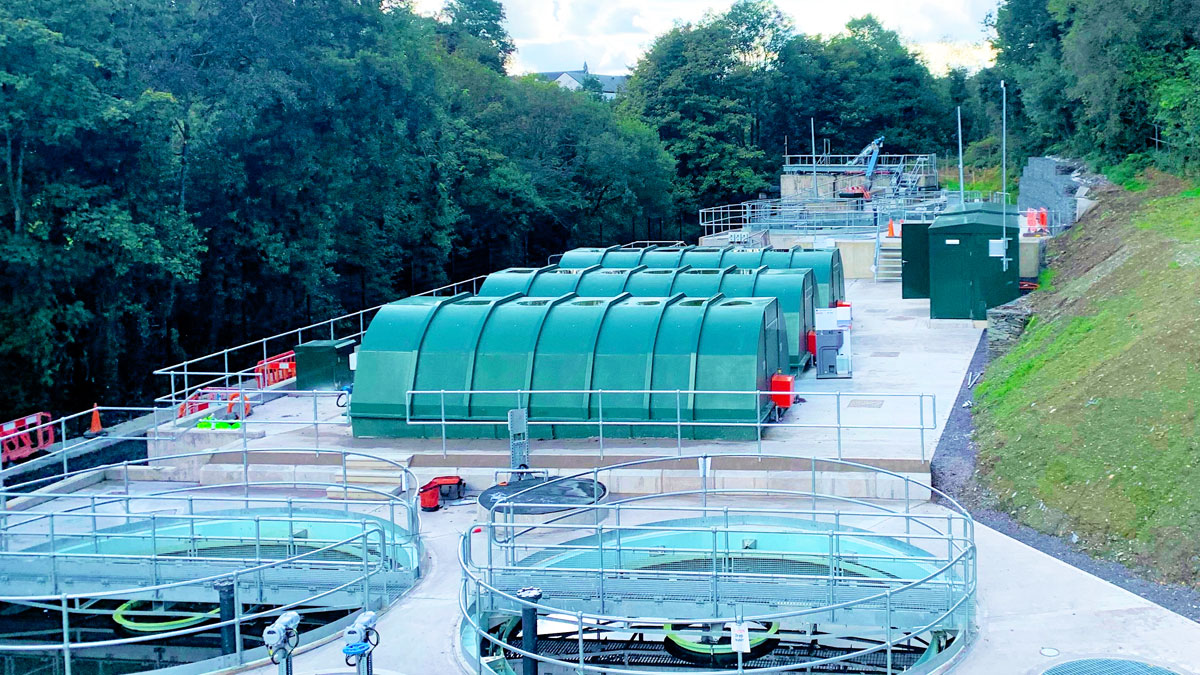
RBCs installed on site – Courtesy of Deane Public Works
The treated effluent from the RBCs is collected within a series of chambers which then gravitates to the two new 6.0m diameter 60° conical GRP final settlement tanks. Similar to the primary tanks, a humus sludge pumping station was provided for the humus sludge and scum for returning to the PST flow split chamber for co-settlement before storing within the sludge storage tank.
The 135m3 sludge storage tank was sized for thirty days’ storage and equipped with an external sludge mixer capable of mixing the sludge tank content to a dry solids of 6% DS. A staggered decant valve arrangement was provided with an additional high level emergency overflow for decant liquors to be transferred to the new return liquors pumping station for a controlled return to the head of the works for further treatment.
The return liquors pumping station was designed to receive flows from various sources such as the automatic decanted liquors from the sludge holding tank, surface water run-off from potentially contaminated areas; for example, tanker loading areas and Inlet screening/skip areas, drainage from process sumps, tanks and any general containment. A priority return system was installed within the PLC programme to ensure incoming flow takes priority for treatment, with storm, humus and return liquors then being returned to the inlet works when the incoming flow subsides.
The new works was supplied with a new MCC housed within a GRP kiosk including HMI and upgraded telemetry.
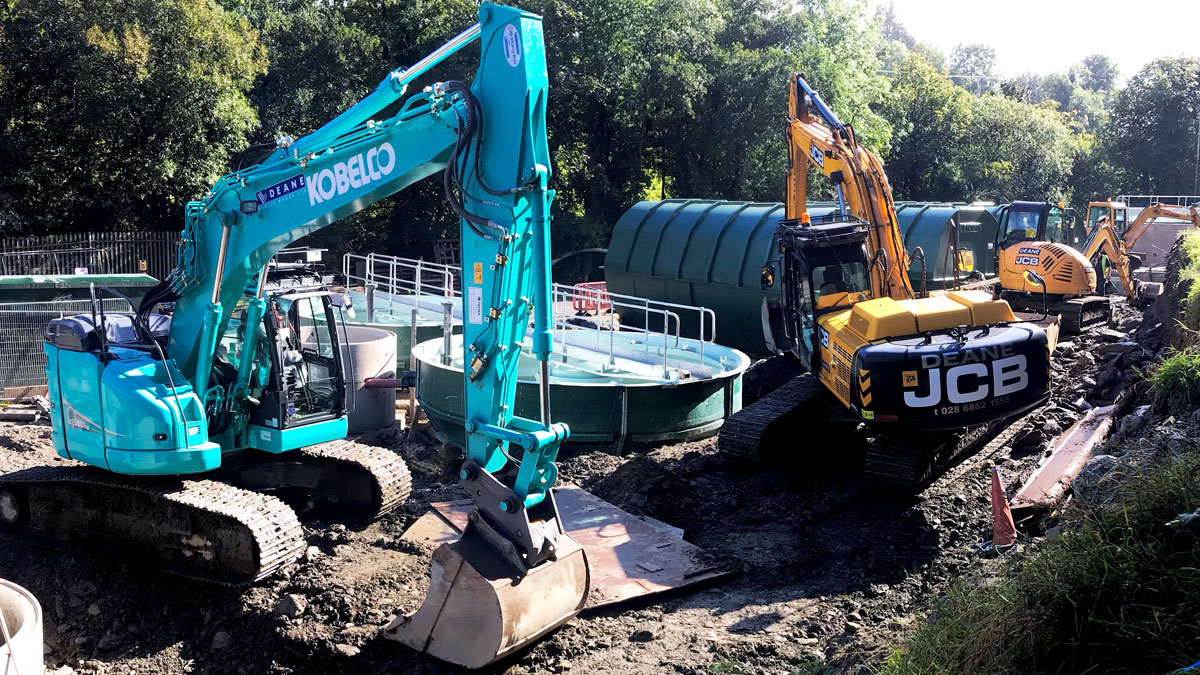
Specialist plant, including a zero tail machine, was employed for the tight site – Courtesy of Deane Public Works
Donemana WwTW: Supply chain – key participants
- Client: Northern Ireland Water
- Client professional services: McAdam Design
- Main contractor: Deane Public Works Ltd
- M&E/process contractor: Water Solutions Ireland
- Civil design: AECOM
- MBR units: Jacopa
- Conical settlement tanks: WPL Ltd
- Temporary treatment works: Siltbuster Ltd
Overcoming construction constraints
The construction phase at Donemana WwTW faced two main constraints: the construction of a new treatment works on a very restricted site with difficult terrain and keeping the existing process operational for the duration of the works. To overcome the confined nature of the site, DPW purchased two new innovative and energy efficient zero tail swing Kobelco excavators with roto-tilt hitches and grabs to manage movement of machinery and safely deliver the site works in the tight areas between the new items of process equipment.
The new infrastructure was located away from the riverbank top and beyond the 100-year fluvial flood plain. Although space-saving RBCs were part of the design, the additional treatment capacity required a large footprint within the existing NI Water site. Because the site was sloped, hard rock excavation was required at the base of the slope in addition to the construction of new retaining wall structures. To promote sustainability and minimise waste, DPW used stone excavated from the Donemana site to construct gabion baskets which were used to form the retaining walls. Over 60 tonnes of stone were reused in total.
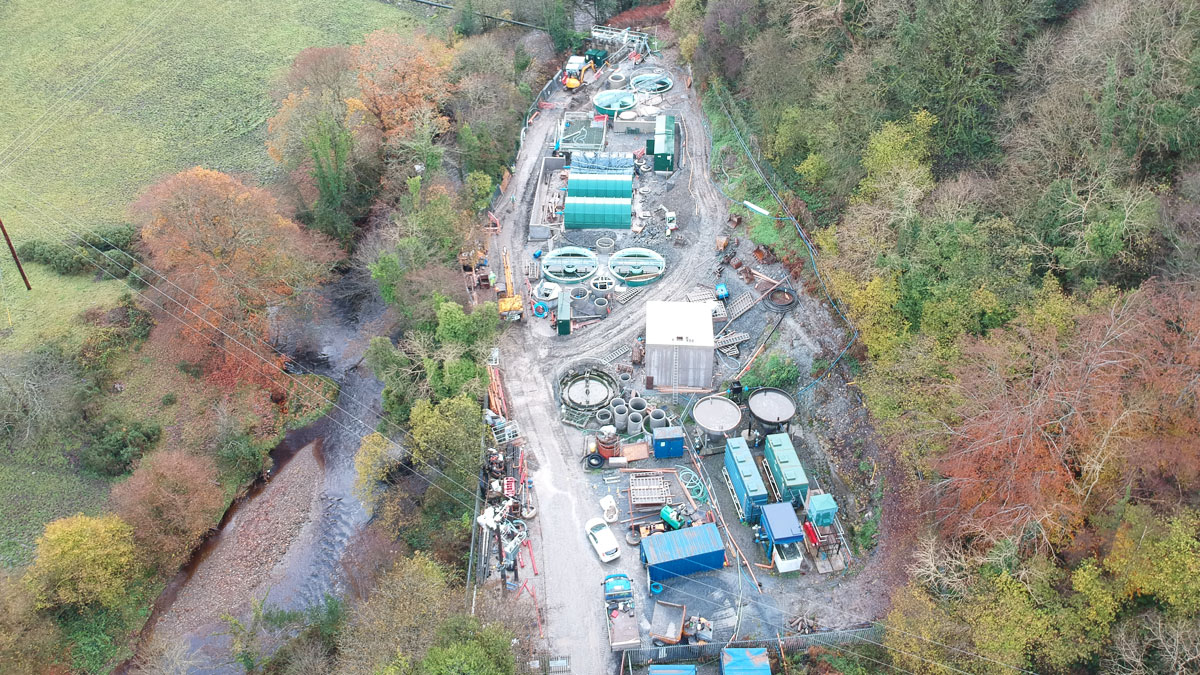
Donemana site progress November 2019 – Courtesy of NI Water/SWELL
All excavations for pipelines required significant dewatering and stabilisation, with increased bracing for pipeline excavations requiring continual monitoring and support with trench boxes or sheet piles.
Safe demolition of existing structures was required to obtain space for construction of the new structures. All above-ground walls were cut down to 300mm below ground level and the ground level reinstated.
Considering the elevated hydraulic profile, the foundation solution for the new structures was excavation/demolition down to suitable stratum and replacement with compacted engineering fill to formation level.
The high-risk structures on the critical path were the storm tank and the inlet works. By working collaboratively with McAdam, AECOM and WSI, and by using complex temporary works and formwork, DPW were able to save time and the critical programme dates were achieved.
DPW worked closely with McAdam and AECOM at design stage to agree construction and sequencing of all structures to ensure temporary and permanent loadings and thermal restraint considerations were considered in the reinforcement design and detailing.
When carrying out excavations for each structure, site access and space were very restricted and there was no room available for stockpiling spoil or construction materials. Therefore, ‘just-in-time’ deliveries were required and material from bulk excavations was sequentially recycled into final landscaping. Well-planned management of materials generated from demolition works resulted in the concrete tanks being crushed on-site to form stone backfill.
As part of our approved Construction Environmental Management Plan, the DPW Project Team developed a specific Invasive Species Management Plan to manage and eradicate patches of Japanese knotweed (Fallopia japonica) and Himalayan balsam (Impatiens glandulifera) that were both located within the compound, adjacent to the access lane and which had encroached into the downstream end of the site.
The Covid-19 pandemic interrupted the construction programme, however DPW managed and overcame all issues with strict site-specific Coronavirus risk management plans and the introduction of an innovative paperless work system for site to further reduce risks. The project was successfully delivered on time to revised/agreed target and on budget.
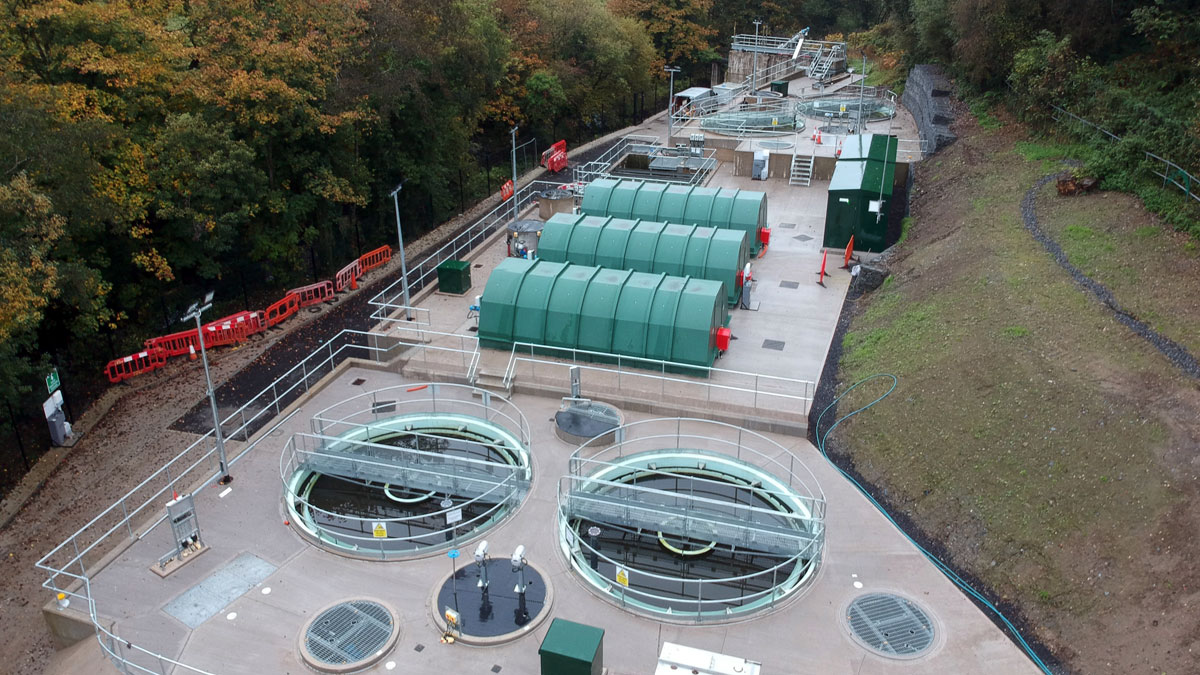
The completed Donemana WwW – Courtesy of NI Water/SWELL
Public/stakeholder engagement
DPW project management of Donemana WwTW achieved Performance Beyond Compliance Certification under the Considerate Constructors’ Scheme, which seeks to improve the image of the construction industry by striving to promote and achieve best practice.
Ahead of construction commencing on site and throughout the work, several public relations activities were employed to advise the general public of plans and keep the various stakeholders informed of developments with the project.
These included: a public information event; letter drops to residents; progress briefings to local elected representatives; press releases in the local media and social media announcements.
DPW facilitated visits to site from the Special EU Programmes Body – a key SWELL stakeholder who manages the INTERREG VA Programme – to show them first-hand the new infrastructure that had been installed to help deliver water quality improvements.
In addition, continuous stakeholder liaison with NI Water, NIEA, Transport NI, elected representatives and the public ensured no stakeholder-driven delays.
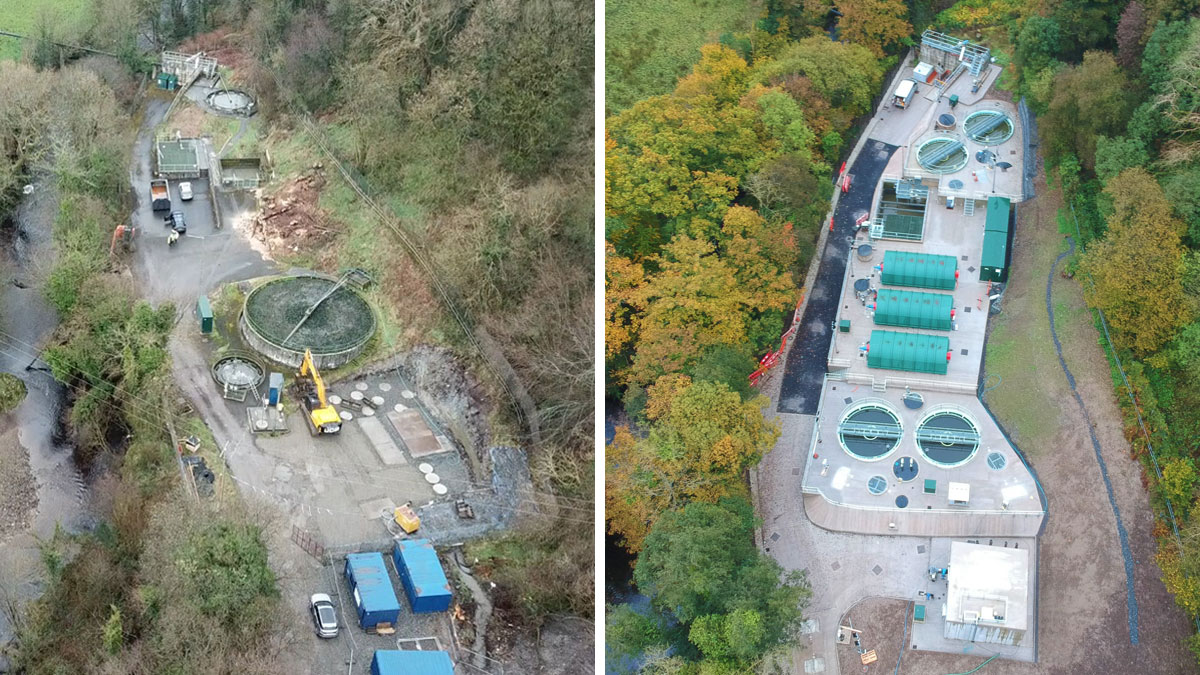
(left) Works at the start of construction and (right) the new Donemana WwTW – Courtesy of NI Water/SWELL
Project success and completion
The collaborative working relationship developed between DPW and NI Water, McAdam, Water Solutions Ireland, Jacopa and AECOM through the ECI process, allowed for greater innovation and the tight programme to flow much more quickly ensuring swift resolution to problems.
The solution designed and constructed by DPW was chosen based on its capability, flexibility and reliability to serve the future catchment needs over a 25-year projection horizon ensuring that NI Water and SWELL targets were met.
The new works was successfully tested, commissioned and handed over to NI Water in February 2021 and is comfortably meeting the NIEA final effluent quality standard of 40 mg/l BOD, 60 mg/l suspended solids and 20 mg/L ammonia.
This hi-tech wastewater treatment solution will accommodate development in the Donemana area and offer increased environmental protection for the adjacent Burn Dennet River and thus the Foyle Estuary for many years to come.




